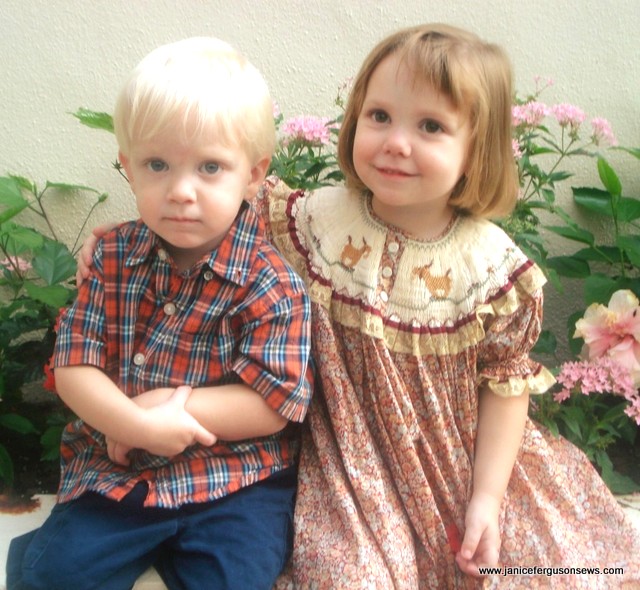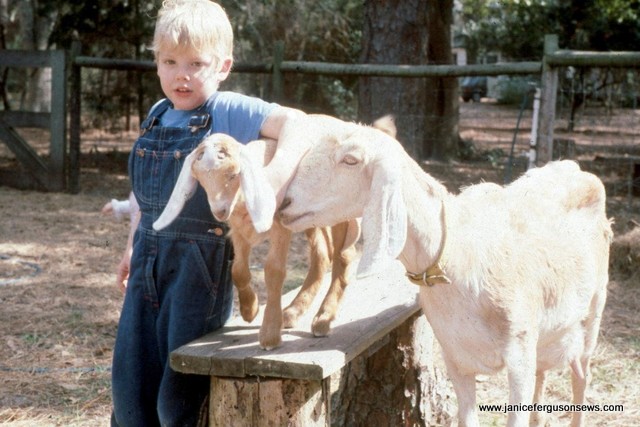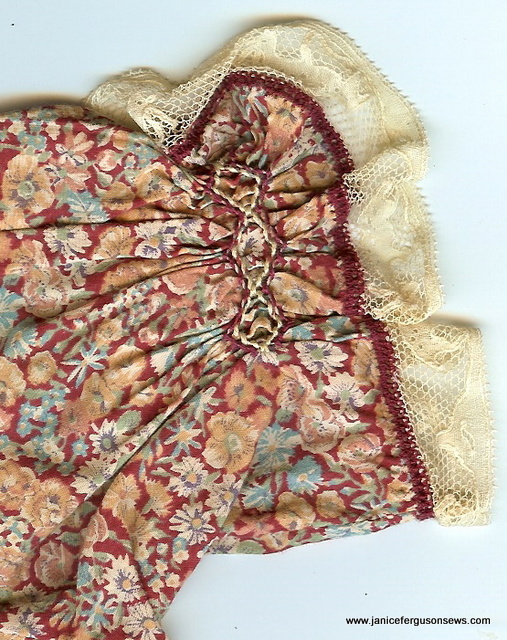Visions of  a “goat dress” had been dancing in my head for many years. In 1985, after purchasing Sarah Howard Stone’s first book, French Handsewing, I studied it with a passion. One page, in particular, spoke to me. It showed row after row of antique laces, including what I call goat lace. I had to have some of this.
 At that time, I was in the middle of my Mother Earth phase. Perhaps some readers recall the publication, The Mother Earth News, or Carla Emery’s Old Fashioned Cook Book. These were daily reading for me.
On our 3 acres stood a 50 year old, formerly upscale, two-room chicken house, where our cocky Rhode Island Red rooster and his girls bunked. The adjoining room housed a gaggle of geese and a few white Peking ducks.  Next door to the water fowl was the pony. Her stall looked out over our 60’ x 60’ vegetable garden and adjacent to that was the goat mansion, my favorite place in the world except for my sewing room.
This truly lovely architectural delight, electrified and built by my indulgent and competent husband, included a screened milk room that would probably have met state dairy standards, with a concrete floor, a custom built milking stanchion and stainless steel scales. We loved our goats.
These winsome, lop eared, Roman nosed Nubians lived the good life for many years, while providing  our family with fresh goat milk. Ultimately, the regimen of twice daily milking became more of a burden than a pleasure.  Our children were busy with piano lessons, soccer, Brownies and all the standard kid  activities.   Maintaining a 7 a.m. and 6 p.m. milking schedule was just to much of a limitation and we shut down the family dairy operation. But we had loved them as pets, so I really wanted that goat lace as a remembrance of a special time in our lives.
It took some doing, but several years later, I located the lace and purchased a 30 yd. card. Goat smocking designs are not common, but when this Billy Goats Gruff design was published in Creative Needle magazine a few years later, I knew I had the makings of a goat dress.
Made years ago for my grandmother’s hope chest, it was pulled out one day in Laurel’s presence and she fell in love with it. Clearly, it is too big for her, but she HAD to have it. So please excuse the obviously oversized dress for an undersize little girl, as well as the surly towhead who did NOT want his picture taken. He certainly looks like his father, Ryan, pictured above 30 years ago. The photo is a scan of a slide which had been damaged. Please disregard the spots. Neither my son nor my goats were blemished in any way.
There are so many interesting features on this garment. One of these is the bishop pattern modification, a solid color contrasting fabric for the smocked portion of the dress. In a 1992 article I wrote for Sew Beautiful magazine, I dubbed this style “novelty bishop” It has which is especially useful for picture smocking on a print fabric.
If you’ve read previous posts in this blog, you know I absolutely love Liberty of London tanna lawn, which is the floral fabric used for the body of this dress. With this print it would have been very difficult to get sufficient contrast for the goats to show up well. As much as I love Liberty prints and bishops, this technique is very useful for me.
To substitute a solid fabric for the smocked section of the dress, you simply measure the distance front center back to center back to determine the length of the piece. Depending on which pattern you use, two 45″ widths of fabric will probably be enough to go from center back to center back on a size 4.
For the width, you measure the distance from the neck edge to bottom row of smocking and add a 1/2″ seam allowance. So if the distance from the raw edge of the pattern piece to the beginning of the curve of the armhole is 4″, you would cut the solid fabric piece 45″ x 4 1/2″.
From the print body of the dress, you subtract the width of the smocked area, i.e. 4″ and subtract the seam allowance from that. So you would eliminate the top 3 1/2″ of the original pattern piece. It is easiest to simply cut out the dress per the pattern and then cut away the 3 1/2″. The solid piece can be pleated before or after being joined to the body of the dress.
For larger sizes, you can use two 60″ widths of  fabrics seamed together and cover that seam with a piece of the print fabric, as seen in the photo.
I like to stitch something along the seam line that joins substituted solid to the print. It softens the visual break and creates a collar effect. On this dress, burgundy lace tape is joined to goat lace, then stitched over the seam line with a narrow zig zag. This keeps the seam allowance facing the hem. There are more tips and fine points to the process, all detailed in that article.
Another interesting feature of the dress is the burgundy lace tape machine made entredeux used on the sleeves. I wish this photo showed how clean and pretty the entredeux is, but this is the best I can do.
My friend Mildred Turner developed this technique, which creates really lovely colored entredeux. Basically, the lace tape is stitched to the raw sleeve edge, overlapping it by 1/4″. The fabric is then pressed up, away from the lace tape. Then the lace edging is placed on top of the lace tape 1/8″ from the sleeve edge. This is the width of the adjusted entredeux stitch. Thread, matching the color of the lace tape is used in the needle and bobbin and the machine made entredeux is stitched. The excess lace tape is trimmed away from under the lace.
Because the lace tape is a soft, loose weave, it fills in the entredeux stitches and gives it more body than if it were stitched on water soluble stabilizer. With a supply of colored lace tape, it is so handy to be able to add colored entredeux to a project.
I hope to get a more current picture of Laurel in the goat dress, now that it fits her better.






2 responses to “Liberty Goat Dress”